PingPull malware (virus) - Free Instructions
PingPull malware Removal Guide
What is PingPull malware?
PingPull malware was developed to gain access to devices and steal passwords, banking details
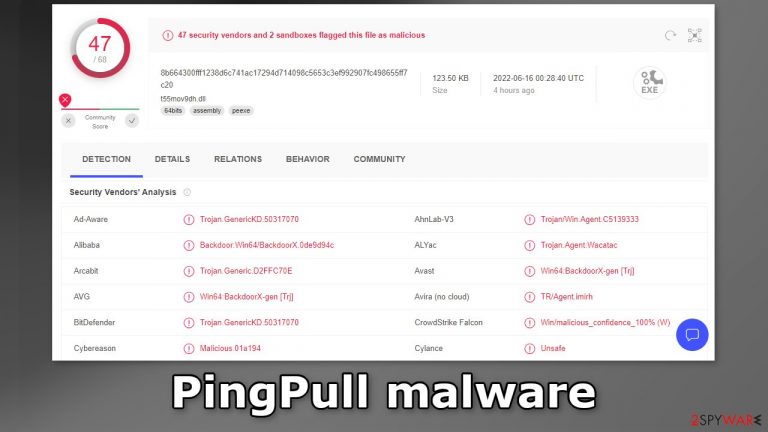
PingPull malware is classified as a RAT (Remote Access Trojan). It can provide remote access and control over your machine to hackers. There is a broad spectrum of things that can be done using such malicious programs. Mainly, it is used to steal personal data, such as login information, passwords, banking details, etc.
The RAT can also manage files – learn folder contents and modify them. Furthermore, many RATs can install other malware, like trojans, ransomware, and cryptocurrency miners without the users' knowledge. Such malware infections can lead to severe privacy issues, significant financial losses, and even identity theft.
Even worse, those machines affected by the malware can be added to a botnet which is a number of Internet-connected devices, each of which runs one or more bots. They can be used to perform Distributed Denial-of-Service (DDoS) attacks,[1] steal data, send spam, and allow the attacker to access the device and its connection.
If you suspect you were infected by this malicious program, we suggest you follow our removal guide fully. You will learn how malware is mostly distributed and how to avoid it. You will also find the professional anti-malware software that we recommend for the removal.
| NAME | PingPull |
| TYPE | Remote Access Trojan; Malware |
| SYMPTOMS | No symptoms are visible to the victims as this malware is designed to infect sneakily and stay silent |
| DISTRIBUTION | Shady websites; “cracked” software installations; infected email attachments |
| DANGERS | The malicious program can steal users' passwords, and banking information, which could lead to identity theft; cybercriminals could add the device to a botnet |
| ELIMINATION | Use professional security tools to eliminate all the malicious files |
| FURTHER STEPS | Use a maintenance tool like FortectIntego to fix any damaged files and optimize the machine |
Gallium hacker group
The PingPull malware is believed to be developed by the Gallium cybercrime group. Many think that it is sponsored by the Chinese state. They are known for their attacks against financial institutions and government entities in Europe, Southeast Asia, and Africa. Microsoft had warned about the group in 2019.[2] However, at the time, they only highlighted a targeting scope limited to telecommunication service providers.

Distribution methods
It is not completely clear how the targeted machines are breached. However, the threat actors are known to exploit internet-exposed applications to gain initial access. We recommend you not to install “cracked” software[3] from torrent websites, freeware, and peer-to-peer file-sharing platforms.
They are unregulated, so they are the perfect breeding ground for all kinds of malware. Besides, crooks can include malicious programs in bundles so users would not notice them. Cybercriminals also often use social engineering techniques[4] to trick people.
They can be used in advertisements, emails, etc. Hackers can create an email that looks like an important message from a well-known brand and include a malicious link or an infected attachment. It is best to analyze the email thoroughly if it asks you to download something or follow a link.
Do not open attachments unless you were expecting them from someone you know. Typically, cybercriminals can hide the malicious code in an executable file (.exe) that may have been in a zip folder, embedded within a Microsoft Office document’s macros, or disguised as a fax or other viable attachment.
The removal process
It can be very difficult to detect and remove PingPull malware on time because it usually operates without showing any visible indications of its presence. It may take weeks, or even months for the victim to notice the effects of the virus activity. If you want to prevent such threats from entering your machine in the future, you should use professional security tools.
A PC without an antivirus is like a house without a door. Anti-malware tools can remove the intruders before they can do any changes to your system. SpyHunter 5Combo Cleaner and Malwarebytes are great tools that you can use for the full elimination of RedLine. We do not recommend performing the removal manually as you can leave some traces behind which could result in the renewal of the infection.
Some Trojan-based programs can block your security software and prevent you from accessing the settings for malware removal. If malware is not letting you use antivirus in normal mode, access Safe Mode and perform a full system scan from there:
Windows 7 / Vista / XP
- Click Start > Shutdown > Restart > OK.
- When your computer becomes active, start pressing F8 button (if that does not work, try F2, F12, Del, etc. – it all depends on your motherboard model) multiple times until you see the Advanced Boot Options window.
- Select Safe Mode with Networking from the list.
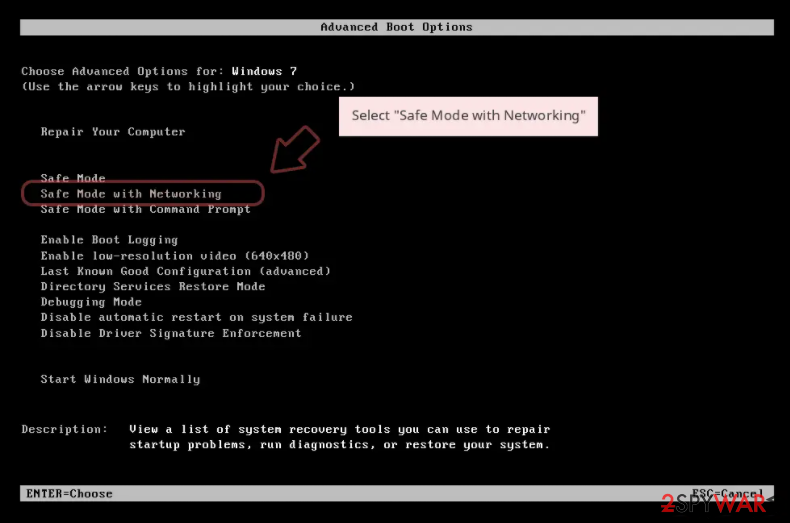
Windows 10 / Windows 8
- Right-click on Start button and select Settings.
- Scroll down to pick Update & Security.
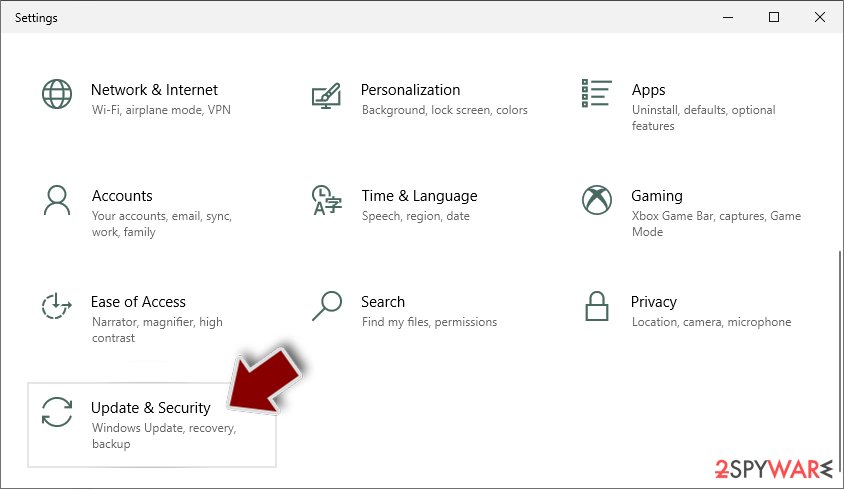
- On the left side of the window, pick Recovery.
- Now scroll down to find Advanced Startup section.
- Click Restart now.

- Select Troubleshoot.
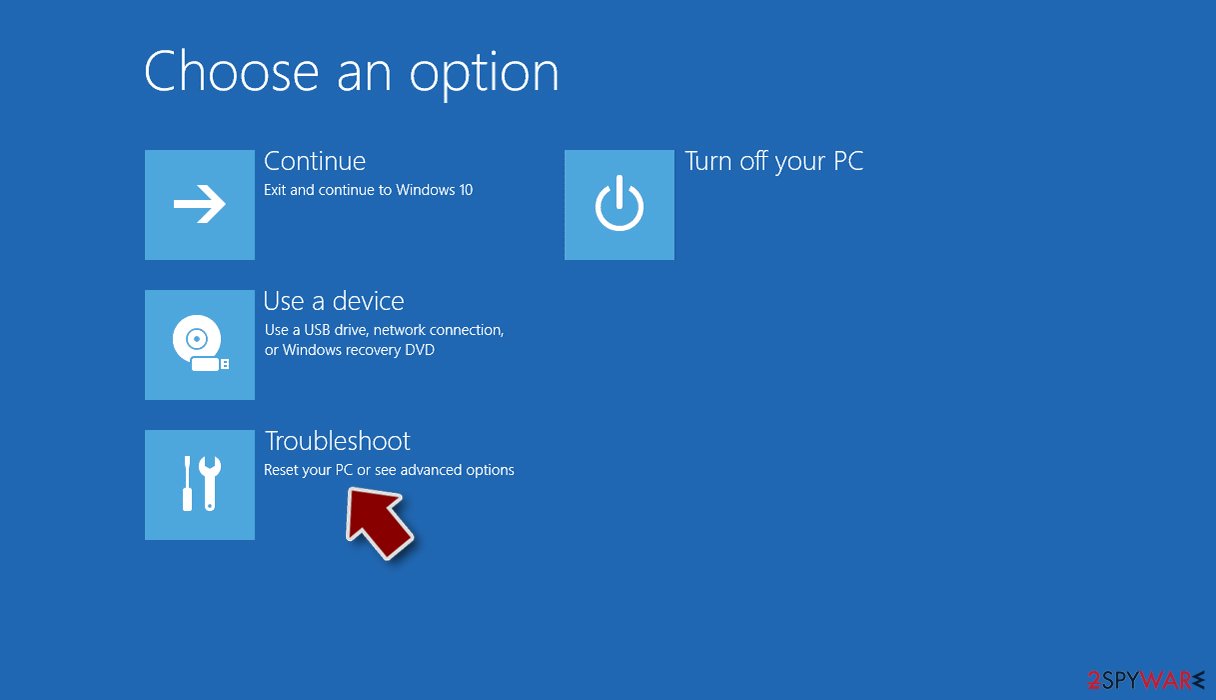
- Go to Advanced options.
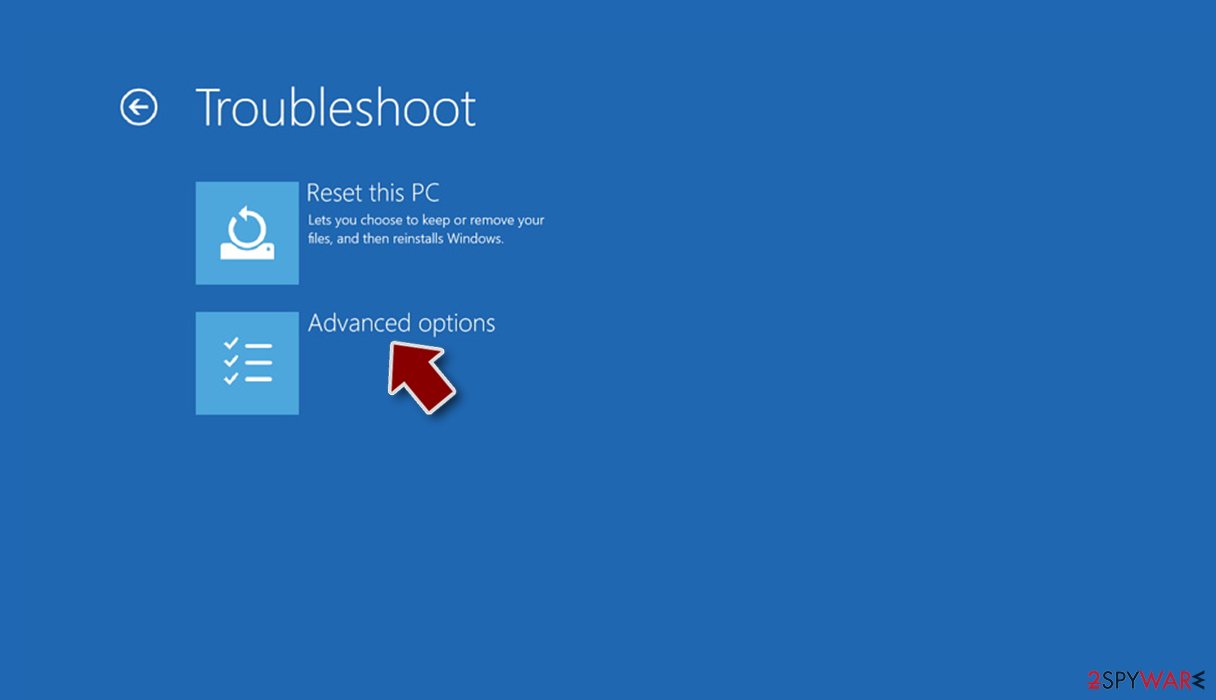
- Select Startup Settings.
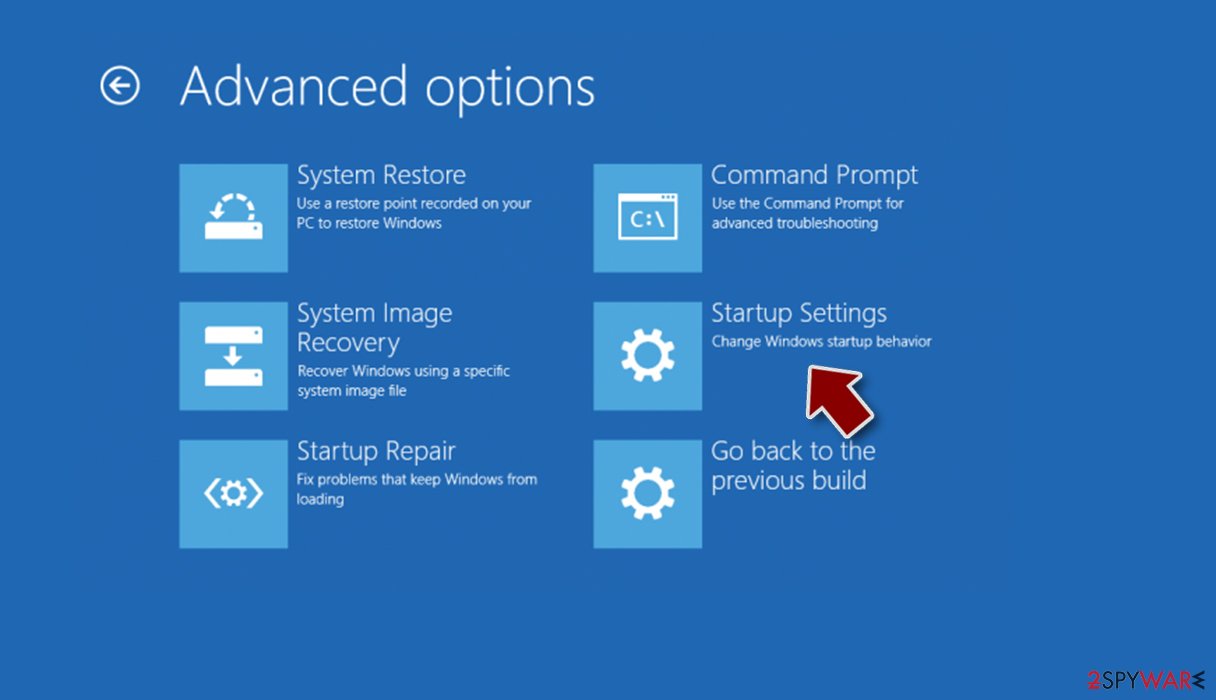
- Click Restart.
- Press 5 or click 5) Enable Safe Mode with Networking.
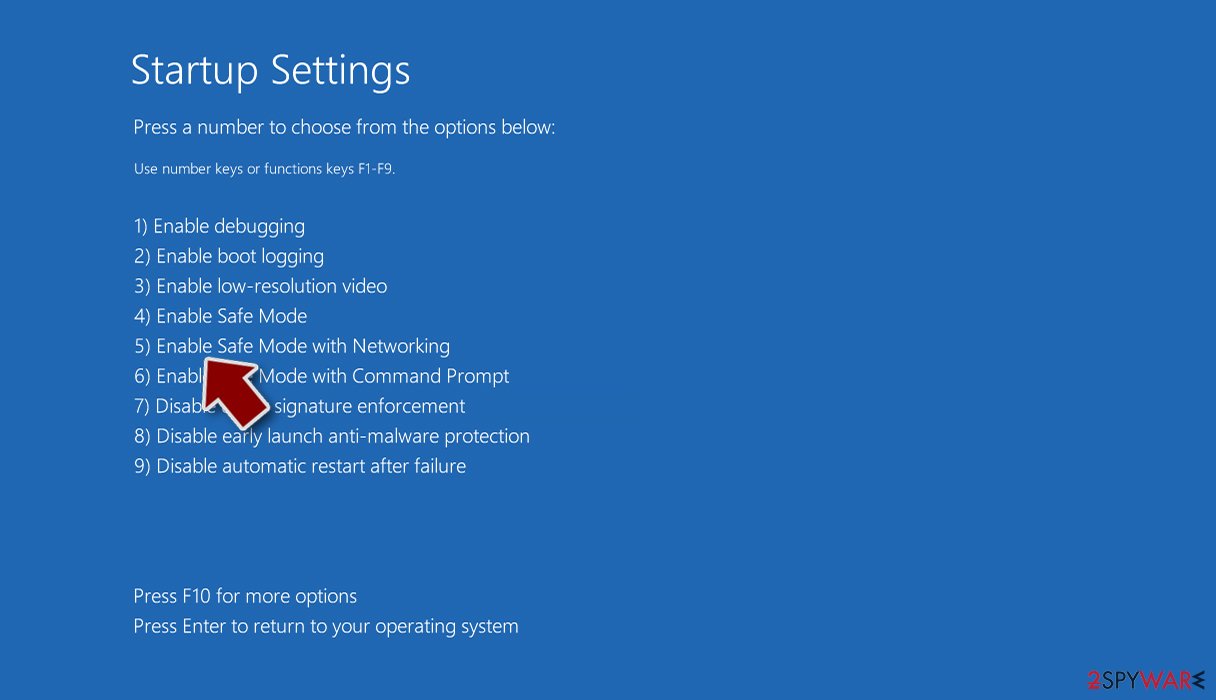
Once you reach Safe Mode, launch SpyHunter 5Combo Cleaner, Malwarebytes, or another reputable antivirus, update it with the latest definitions and perform a full system scan to eradicate malware and all its malicious components.
Repair the damaged operating system
Performance, stability, and usability issues, to the point where a full Windows reinstall is required, are nothing unusual after a malware infection. These types of intruders can alter the Windows registry database, damage vital bootup, and other sections, delete or corrupt DLL files, etc. Once a system file is damaged, antivirus software cannot fix it.
Manual troubleshooting of such damage is also very complicated and can take a long time. This is why FortectIntego was developed. It can fix a lot of the damage caused by an infection like this. Blue Screen errors, freezes, registry errors, damaged DLLs, etc., can make your computer completely unusable. By using this useful maintenance tool, you could prevent yourself from having to reinstall Windows completely.
- Download the application by clicking on the link above
- Click on the ReimageRepair.exe
- If User Account Control (UAC) shows up, select Yes
- Press Install and wait till the program finishes the installation process
- The analysis of your machine will begin immediately
- Once complete, check the results – they will be listed in the Summary
- You can now click on each of the issues and fix them manually
- If you see many problems that you find difficult to fix, we recommend you purchase the license and fix them automatically.
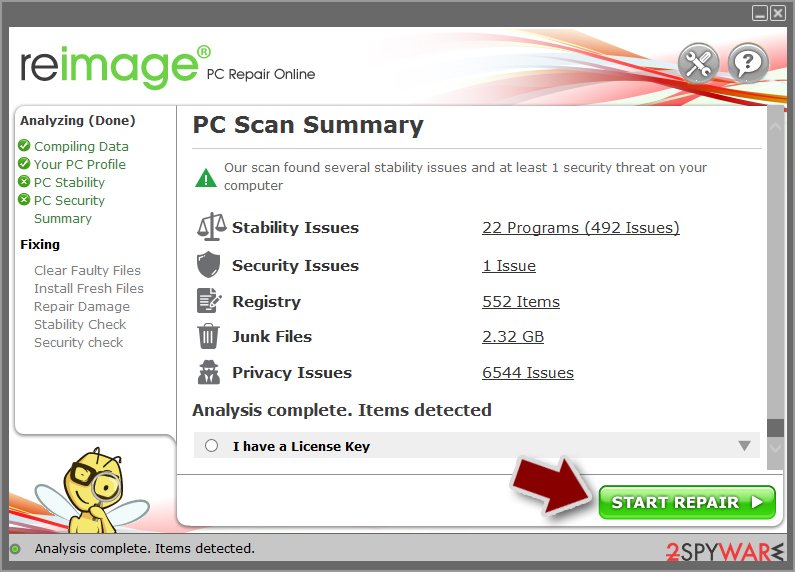
If you experience setting changes in your browsers, like the homepage, new tab address, redirects, or push notifications, you can look for instructions on how to deal with those issues below this article. There is a big chance that the malware automatically installed other threats that could cause unwanted symptoms in your browsers. Guides are available for Google Chrome, Mozilla Firefox, MS Edge, and Internet Explorer.
Getting rid of PingPull malware. Follow these steps
Remove from Google Chrome
Delete malicious extensions from Google Chrome:
- Open Google Chrome, click on the Menu (three vertical dots at the top-right corner) and select More tools > Extensions.
- In the newly opened window, you will see all the installed extensions. Uninstall all the suspicious plugins that might be related to the unwanted program by clicking Remove.

Clear cache and web data from Chrome:
- Click on Menu and pick Settings.
- Under Privacy and security, select Clear browsing data.
- Select Browsing history, Cookies and other site data, as well as Cached images and files.
- Click Clear data.

Change your homepage:
- Click menu and choose Settings.
- Look for a suspicious site in the On startup section.
- Click on Open a specific or set of pages and click on three dots to find the Remove option.
Reset Google Chrome:
If the previous methods did not help you, reset Google Chrome to eliminate all the unwanted components:
- Click on Menu and select Settings.
- In the Settings, scroll down and click Advanced.
- Scroll down and locate Reset and clean up section.
- Now click Restore settings to their original defaults.
- Confirm with Reset settings.

Remove from Mozilla Firefox (FF)
Remove dangerous extensions:
- Open Mozilla Firefox browser and click on the Menu (three horizontal lines at the top-right of the window).
- Select Add-ons.
- In here, select unwanted plugin and click Remove.

Reset the homepage:
- Click three horizontal lines at the top right corner to open the menu.
- Choose Options.
- Under Home options, enter your preferred site that will open every time you newly open the Mozilla Firefox.
Clear cookies and site data:
- Click Menu and pick Settings.
- Go to Privacy & Security section.
- Scroll down to locate Cookies and Site Data.
- Click on Clear Data…
- Select Cookies and Site Data, as well as Cached Web Content and press Clear.

Reset Mozilla Firefox
If clearing the browser as explained above did not help, reset Mozilla Firefox:
- Open Mozilla Firefox browser and click the Menu.
- Go to Help and then choose Troubleshooting Information.

- Under Give Firefox a tune up section, click on Refresh Firefox…
- Once the pop-up shows up, confirm the action by pressing on Refresh Firefox.

Remove from Microsoft Edge
Delete unwanted extensions from MS Edge:
- Select Menu (three horizontal dots at the top-right of the browser window) and pick Extensions.
- From the list, pick the extension and click on the Gear icon.
- Click on Uninstall at the bottom.

Clear cookies and other browser data:
- Click on the Menu (three horizontal dots at the top-right of the browser window) and select Privacy & security.
- Under Clear browsing data, pick Choose what to clear.
- Select everything (apart from passwords, although you might want to include Media licenses as well, if applicable) and click on Clear.

Restore new tab and homepage settings:
- Click the menu icon and choose Settings.
- Then find On startup section.
- Click Disable if you found any suspicious domain.
Reset MS Edge if the above steps did not work:
- Press on Ctrl + Shift + Esc to open Task Manager.
- Click on More details arrow at the bottom of the window.
- Select Details tab.
- Now scroll down and locate every entry with Microsoft Edge name in it. Right-click on each of them and select End Task to stop MS Edge from running.

If this solution failed to help you, you need to use an advanced Edge reset method. Note that you need to backup your data before proceeding.
- Find the following folder on your computer: C:\\Users\\%username%\\AppData\\Local\\Packages\\Microsoft.MicrosoftEdge_8wekyb3d8bbwe.
- Press Ctrl + A on your keyboard to select all folders.
- Right-click on them and pick Delete

- Now right-click on the Start button and pick Windows PowerShell (Admin).
- When the new window opens, copy and paste the following command, and then press Enter:
Get-AppXPackage -AllUsers -Name Microsoft.MicrosoftEdge | Foreach {Add-AppxPackage -DisableDevelopmentMode -Register “$($_.InstallLocation)\\AppXManifest.xml” -Verbose

Instructions for Chromium-based Edge
Delete extensions from MS Edge (Chromium):
- Open Edge and click select Settings > Extensions.
- Delete unwanted extensions by clicking Remove.

Clear cache and site data:
- Click on Menu and go to Settings.
- Select Privacy, search and services.
- Under Clear browsing data, pick Choose what to clear.
- Under Time range, pick All time.
- Select Clear now.

Reset Chromium-based MS Edge:
- Click on Menu and select Settings.
- On the left side, pick Reset settings.
- Select Restore settings to their default values.
- Confirm with Reset.

How to prevent from getting malware
Protect your privacy – employ a VPN
There are several ways how to make your online time more private – you can access an incognito tab. However, there is no secret that even in this mode, you are tracked for advertising purposes. There is a way to add an extra layer of protection and create a completely anonymous web browsing practice with the help of Private Internet Access VPN. This software reroutes traffic through different servers, thus leaving your IP address and geolocation in disguise. Besides, it is based on a strict no-log policy, meaning that no data will be recorded, leaked, and available for both first and third parties. The combination of a secure web browser and Private Internet Access VPN will let you browse the Internet without a feeling of being spied or targeted by criminals.
No backups? No problem. Use a data recovery tool
If you wonder how data loss can occur, you should not look any further for answers – human errors, malware attacks, hardware failures, power cuts, natural disasters, or even simple negligence. In some cases, lost files are extremely important, and many straight out panic when such an unfortunate course of events happen. Due to this, you should always ensure that you prepare proper data backups on a regular basis.
If you were caught by surprise and did not have any backups to restore your files from, not everything is lost. Data Recovery Pro is one of the leading file recovery solutions you can find on the market – it is likely to restore even lost emails or data located on an external device.
- ^ Denial-of-service attack. Wikipedia, the free encyclopedia.
- ^ Liam Tung. Microsoft warns this hacking group is targeting vulnerable web servers. Zdnet. Security News.
- ^ Georgina Torbet. 5 Security Reasons Not to Download Cracked Software. Makeuseof. Security Blog.
- ^ Cynthia Gonzalez. Top 8 Social Engineering Techniques and How to Prevent Them [2022]. Exabeam. Information Security.
